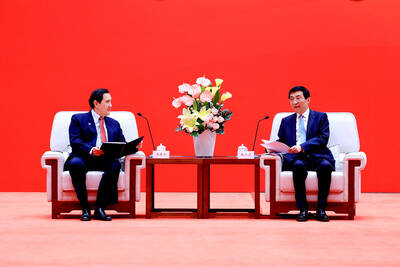Major Japanese companies are bearish over the prospects for the country’s crisis-hit economy, with a majority of them seeing a recovery as unlikely until 2010, surveys showed yesterday.
The Mainichi Shimbun carried out a corporate sentiment survey late last month, covering 121 major companies across the nation, including leading names such as Toyota Motor Corp and Sony Corp.
The poll showed that 41 percent of the respondents said the Japanese economy would recover in the first half of 2010 and 24 percent said a rebound would come in the second half of next year.
None at all expected the economy to recover in the first half of this year, while 22 percent forecast that things would get better later this year.
In a separate poll carried out by the Tokyo Shimbun, 68 percent of companies said the economy would pick up next year, while 14 percent said the recovery would be delayed until 2011 or later.
One in four companies said they have already cut or planned to cut temporary contract workers, the survey carried out last month of 208 major companies showed.
Japanese companies have cut tens of thousands of jobs, mostly temporary contract workers, as demand for cars, cameras and other products wanes amid the global financial crisis.
Meanwhile, Japan’s central bank chief warned yesterday that the soaring yen was hurting Asia’s largest economy and said he was looking at measures to cope with it.
The yen recently hit a 13-year high against the dollar after the US Federal Reserve cut interest rates to virtually zero. A strong yen makes Japanese exports less competitive and cuts into repatriated earnings.
“Amid the rapid downturn of the global economy, a strong yen has a negative impact on the [Japanese] economy,” Bank of Japan governor Masaaki Shirakawa told public broadcaster NHK.
“The impact is big. So we, the central bank, would like to keep thinking of ways to cope with it, including through monetary policy,” he said.
Shirakawa said the central bank would keep studying how it could lower private banks’ lending rates and make it easier for companies to procure the money they need for investment.
But the bank has little room left to cut benchmark interest rates. On Dec. 19, it slashed its key rate to 0.1 percent to cope with the worsening global slowdown.
The government has repeatedly hinted it could order the bank to intervene on the market to bring down the yen. Japan has not intervened on the foreign exchange market for nearly five years.
Some analysts doubt whether intervention would be effective, considering the market’s negative view about the dollar in light of the woes in the US economy.
The yen last week slipped to about 92 to the dollar, down from its 13-year high in the middle of last month of 87 to the dollar. It was at 114 to the US currency one year ago.

LONG FLIGHT: The jets would be flown by US pilots, with Taiwanese copilots in the two-seat F-16D variant to help familiarize them with the aircraft, the source said The US is expected to fly 10 Lockheed Martin F-16C/D Block 70/72 jets to Taiwan over the coming months to fulfill a long-awaited order of 66 aircraft, a defense official said yesterday. Word that the first batch of the jets would be delivered soon was welcome news to Taiwan, which has become concerned about delays in the delivery of US arms amid rising military tensions with China. Speaking on condition of anonymity, the official said the initial tranche of the nation’s F-16s are rolling off assembly lines in the US and would be flown under their own power to Taiwan by way

CHIP WAR: The new restrictions are expected to cut off China’s access to Taiwan’s technologies, materials and equipment essential to building AI semiconductors Taiwan has blacklisted Huawei Technologies Co (華為) and Semiconductor Manufacturing International Corp (SMIC, 中芯), dealing another major blow to the two companies spearheading China’s efforts to develop cutting-edge artificial intelligence (AI) chip technologies. The Ministry of Economic Affairs’ International Trade Administration has included Huawei, SMIC and several of their subsidiaries in an update of its so-called strategic high-tech commodities entity list, the latest version on its Web site showed on Saturday. It did not publicly announce the change. Other entities on the list include organizations such as the Taliban and al-Qaeda, as well as companies in China, Iran and elsewhere. Local companies need

CRITICISM: It is generally accepted that the Straits Forum is a CCP ‘united front’ platform, and anyone attending should maintain Taiwan’s dignity, the council said The Mainland Affairs Council (MAC) yesterday said it deeply regrets that former president Ma Ying-jeou (馬英九) echoed the Chinese Communist Party’s (CCP) “one China” principle and “united front” tactics by telling the Straits Forum that Taiwanese yearn for both sides of the Taiwan Strait to move toward “peace” and “integration.” The 17th annual Straits Forum yesterday opened in Xiamen, China, and while the Chinese Nationalist Party’s (KMT) local government heads were absent for the first time in 17 years, Ma attended the forum as “former KMT chairperson” and met with Chinese People’s Political Consultative Conference Chairman Wang Huning (王滬寧). Wang

OBJECTS AT SEA: Satellites with synthetic-aperture radar could aid in the detection of small Chinese boats attempting to illegally enter Taiwan, the space agency head said Taiwan aims to send the nation’s first low Earth orbit (LEO) satellite into space in 2027, while the first Formosat-8 and Formosat-9 spacecraft are to be launched in October and 2028 respectively, the National Science and Technology Council said yesterday. The council laid out its space development plan in a report reviewed by members of the legislature’s Education and Culture Committee. Six LEO satellites would be produced in the initial phase, with the first one, the B5G-1A, scheduled to be launched in 2027, the council said in the report. Regarding the second satellite, the B5G-1B, the government plans to work with private contractors